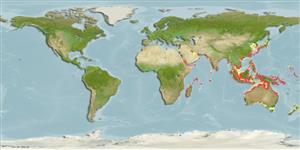Environment: milieu / climate zone / depth range / distribution range
Οικολογία
Θαλασσινό(ά); αμφίδρομο (Ref. 51243); εύρος βάθους 5 - 100 m (Ref. 52753). Tropical; 40°N - 12°S, 47°E - 143°E
Indo-West Pacific.
Length at first maturity / Μέγεθος / Βάρος / Age
Maturity: Lm 21.0 range ? - ? cm
Max length : 31.6 cm TL αρσενικό/απροσδιόριστο; (Ref. 121654)
Ραχιαίες άκανθες (συνολικά) : 9; Μαλακές ραχιαίες ακτίνες (συνολικά) : 21 - 22; Εδρικές άκανθες: 3; Μαλακές εδρικές ακτίνες: 17 - 18. This species is easily recognized by its long pelvic fin which fit into a groove along the midline of the belly when depressed. Scutes are present along its straight lateral line. Adult males have prolonged middle rays in the soft dorsal and anal fins. This species attains 25 cm in SL.
Adults are common in shallow coastal waters where they often swim near the surface. They feed mainly on shrimps, copepods, decapod crustaceans and small fish.
Life cycle and mating behavior
Maturities | Αναπαραγωγή | Spawnings | Egg(s) | Fecundities | Προνύμφες
Masuda, H., K. Amaoka, C. Araga, T. Uyeno and T. Yoshino, 1984. The fishes of the Japanese Archipelago. Vol. 1. Tokai University Press, Tokyo, Japan. 437 p. (text). (Ref. 559)
IUCN Red List Status (Ref. 130435)
Threat to humans
Harmless
Human uses
αλιεία: περιορισμένης εμπορικότητας
Εργαλεία
Special reports
Download XML
Διαδικτυακές πηγές
Estimates based on models
Preferred temperature (Ref.
123201): 23.5 - 29.2, mean 28.2 °C (based on 1522 cells).
Phylogenetic diversity index (Ref.
82804): PD
50 = 1.0000 [Uniqueness, from 0.5 = low to 2.0 = high].
Bayesian length-weight: a=0.02089 (0.01183 - 0.03689), b=2.87 (2.72 - 3.02), in cm total length, based on LWR estimates for this species & (Sub)family-body (Ref.
93245).
Τροφικό Επίπεδο (Ref.
69278): 3.6 ±0.52 se; based on food items.
Generation time: 2.0 ( na - na) years. Estimated as median ln(3)/K based on 2
growth studies.
Ελαστικότητα (Ref.
120179): Υψηλό, ελάχιστος χρόνος για διπλασιασμό πληθυσμού < 15 μήνες (Preliminary K or Fecundity.).
Fishing Vulnerability (Ref.
59153): Low vulnerability (18 of 100).
Nutrients (Ref.
124155): Calcium = 197 [92, 426] mg/100g; Iron = 1.79 [0.95, 3.80] mg/100g; Protein = 18.6 [17.3, 19.9] %; Omega3 = 0.247 [0.129, 0.485] g/100g; Selenium = 51 [23, 115] μg/100g; VitaminA = 14.4 [3.5, 52.1] μg/100g; Zinc = 1.14 [0.73, 1.81] mg/100g (wet weight);
